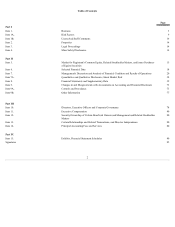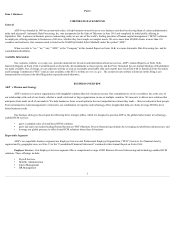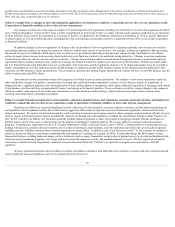ADP 2015 Annual Report Download - page 13
Download and view the complete annual report
Please find page 13 of the 2015 ADP annual report below. You can navigate through the pages in the report by either clicking on the pages listed below, or by using the keyword search tool below to find specific information within the annual report.
our systems. Unauthorized parties may also attempt to gain access to our systems or facilities, or those of third-parties with whom we do business, through fraud,
trickery, or other methods of deceiving our employees, contractors, and temporary staff. As these threats continue to evolve, we may be required to invest
significant additional resources to modify and enhance our information security and controls and to investigate and remediate any security vulnerabilities. In
addition, while our operating environments are designed to safeguard and protect personal and business information, we do not have the ability to monitor the
implementation or effectiveness of any safeguards by our clients, vendors or their respective employees, and, in any event, third-parties may be able to circumvent
those security measures.
Any cyber attack, unauthorized intrusion, malicious software infiltration, network disruption, denial of service, corruption of data, theft of non-public or
other sensitive information, or similar act by a malevolent party, or inadvertent acts by our own employees, contractors or temporary staff, could result in the
disclosure or misuse of confidential or proprietary information, and could have a materially adverse effect on our business operations, or that of our clients, create
financial liability, regulatory sanction or a loss of confidence in our ability to serve clients, or cause current or potential clients to choose another service provider.
Although we believe that we maintain a robust program of information security and controls and none of the threats that we have encountered to date have
materially impacted us, a data security incident could have a materially adverse effect on our business, results of operations and financial condition. While ADP
maintains insurance coverage that, subject to policy terms and conditions and a significant self-insured retention, is designed to address losses or claims that may
arise in connection with certain aspects of cyber risks, such insurance coverage may be insufficient to cover all losses or all types of claims that may arise in the
continually evolving area of cyber risk.
Our systems may be subject to disruptions that could have a materially adverse effect on our business and reputation
Many of our businesses are highly dependent on our ability to process, on a daily basis, a large number of complicated transactions. We rely heavily on
our payroll, financial, accounting, and other data processing systems. If any of these systems fails to operate properly or becomes disabled even for a brief period
of time, we could suffer financial loss, a disruption of our businesses, liability to clients, regulatory intervention, or damage to our reputation, any of which could
have a materially adverse effect on our results of operation or financial condition. We have disaster recovery, business continuity, and crisis management plans and
procedures designed to protect our businesses against a multitude of events, including natural disasters, military or terrorist actions, power or communication
failures, or similar events. Despite our preparations, our plans may not be successful in preventing the loss of client data, service interruptions, disruptions to our
operations, or damage to our important facilities.
If we fail to adapt our technology and services to meet client needs and preferences, the demand for our solutions and services may diminish
Our businesses operate in industries that are subject to rapid technological advances and changing client needs and preferences. In order to remain
competitive and responsive to client demands, we continually upgrade, enhance, and expand our existing solutions and services. If we fail to respond successfully
to technology challenges and client needs and preferences, the demand for our solutions and services may diminish.
Political and economic factors may adversely affect our business and financial results
Trade, monetary and fiscal policies, and political and economic conditions may substantially change, and credit markets may experience periods of
constriction and volatility. When there is a slowdown in the economy, employment levels and interest rates may decrease with a corresponding impact on our
businesses. Clients may react to worsening conditions by reducing their spending on payroll and other outsourcing services or renegotiating their contracts with us,
which may adversely affect our business and financial results.
We invest our client funds in liquid, investment-grade marketable securities, money market securities, and other cash equivalents. Nevertheless, our client
fund assets are subject to general market, interest rate, credit, and liquidity risks. These risks may be exacerbated, individually or in unison, during periods of
unusual financial market volatility. In addition, as part of our client funds investment strategy, we extend the maturities of our investment portfolio for client funds
and utilize short-term financing arrangements to satisfy our short-term funding requirements related to client funds obligations. In order to satisfy these short term
funding requirements, we maintain access to various sources of liquidity, including borrowings under our commercial paper program and our committed credit
facilities, our ability to execute reverse repurchase transactions and corporate cash balances. A reduction in the availability of any such financing during periods of
disruption in the financial
12
























